What Is Terry Cloth? A Simple Guide To Absorbent Looped Fabric
Have you ever used a soft towel after a bath? That’s often terry cloth! Terry cloth is a common fabric we encounter daily, especially in our softest towels. This article will simply explain what terry cloth is, why it’s special, and how to take care of it. Let’s learn together!
1. What exactly is terry cloth?
1.1 Simple definition
Terry cloth is a type of fabric with many tiny loops of thread on its surface. Think of a carpet, but with very small, soft loops made of thread, all over it. These loops are what make terry cloth different from flat fabrics like the material of your t-shirt or bed sheets. You can see and feel these loops.
1.2 How are the loops made?
Terry cloth is usually made on a special machine. When it’s woven, there are two sets of threads. One set of threads makes the flat bottom part of the fabric. The other set of threads is made into loops that stick out from this bottom part. The machine pulls these threads to make the loops. It’s like making tiny arches with thread all over the fabric.
1.3 Why are these loops so special?
The main reason these loops are special is because they help the fabric soak up a lot of water. Each tiny loop adds more surface to the fabric. More surface means more places for water to grab onto and be absorbed. These loops also make terry cloth feel soft and a bit fluffy. This is why it’s great for towels!
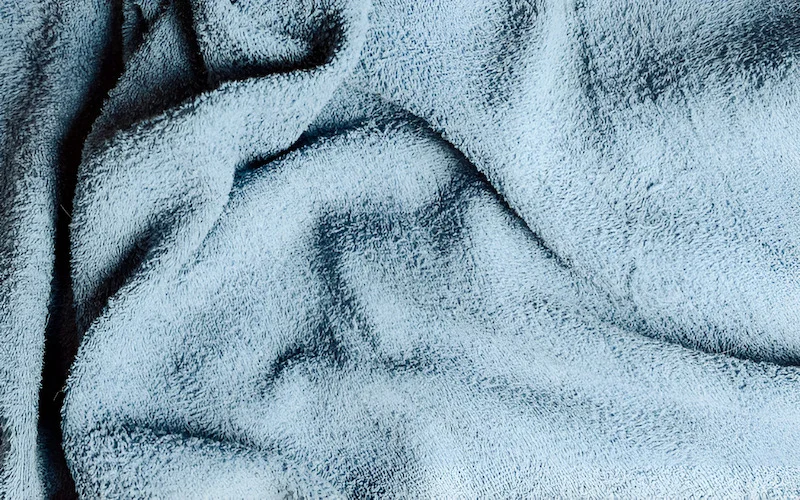
2. Key features of terry cloth
Terry cloth has some great qualities that make it so popular.
2.1 Super absorbent
The most important feature of terry cloth is that it is super absorbent. This means it can soak up liquids, especially water, very well. Remember those loops? They create a lot more surface area than a flat piece of fabric. Think of it like this: a flat paper towel can soak up some water, but a sponge (which has many little holes and surfaces) can soak up much more. Terry cloth loops work a bit like tiny sponges. This is why towels are made from terry cloth – to dry you quickly!
2.2 Soft and comfortable
Terry cloth is also known for being soft and comfortable against your skin. The loops give it a plush, cushiony feel. It’s not flat and hard. This makes it perfect for things like bathrobes, baby towels, and anything you want to feel cozy.
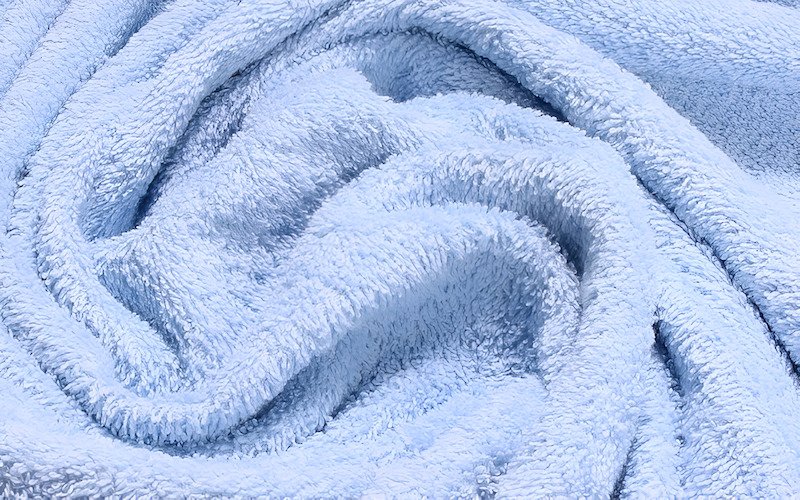
2.3 Durable and long-lasting
Terry cloth is generally a durable fabric. Its woven loop construction makes it tough enough to withstand frequent use and washing, ensuring your terry items have a long lifespan if cared for properly.
2.4 What is terry cloth made from?
Terry cloth can be made from a few different materials, but one is most common.
- Cotton: Most terry cloth is made from cotton. Cotton is a natural plant fiber. It’s soft, it naturally soaks up water well, and it lets air pass through (it’s breathable). These qualities make cotton perfect for making absorbent and comfortable terry cloth.
- Polyester Blends: Sometimes, man-made fibers like polyester are mixed with cotton to make terry cloth. Adding a bit of polyester can make the fabric even stronger, help it dry a little faster, or stop it from shrinking too much when washed.
- Organic Cotton: You might also see terry cloth made from organic cotton. This means the cotton was grown without certain chemicals.
Usually, cotton is the main star because it’s so good at being soft and absorbent.
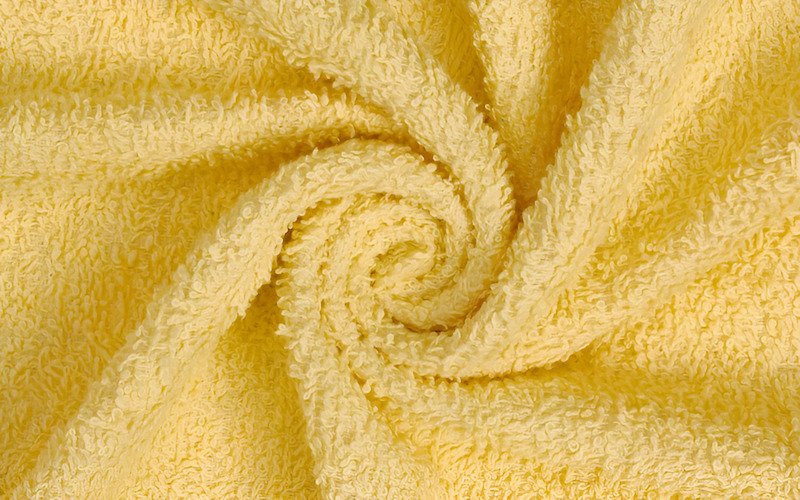
3. Different kinds of terry cloth
Not all terry cloth is exactly the same. Here are the main types you might find.
3.1 Standard terry cloth
This is the most common type you see. Standard terry cloth has loops on both sides of the fabric. This means it feels soft and absorbent no matter which side touches you. Most bath towels, hand towels, and washcloths are made of this standard terry cloth. If you have a towel in your bathroom, it’s probably this kind.
3.2 French terry
French terry is a special kind of terry cloth. It has loops on only one side of the fabric. The other side is flat and smooth, like the fabric of a t-shirt. Because it has loops on only one side, French terry is often lighter and not as thick as standard terry cloth.
You’ll often find French terry used for comfortable clothes like sweatshirts, hoodies, joggers (casual pants), and sometimes shorts or light jackets. It’s popular for loungewear and activewear. The smooth side feels nice against your skin, and the looped side still helps to soak up a little moisture and gives some softness.
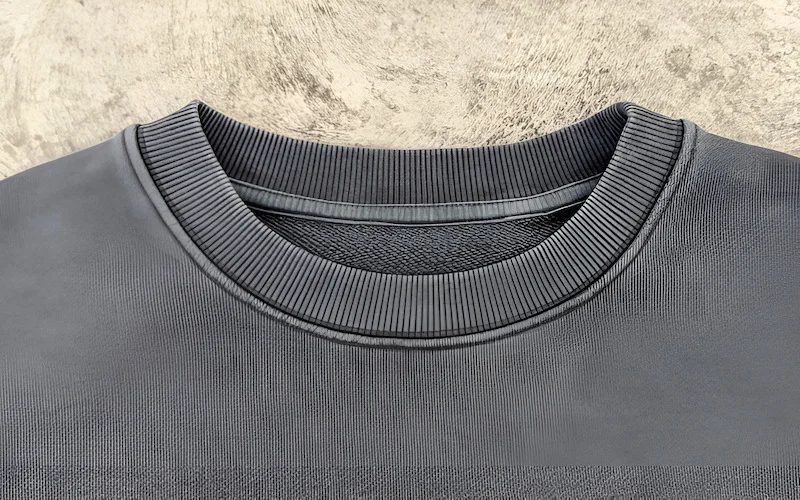
3.3 Terry velour
Terry velour starts out like standard terry cloth with loops on both sides. But then, on one side, the very tops of the loops are cut off (this is called shearing). When the loop tops are cut, it creates a very soft, smooth, and dense surface on that side. It feels a bit like velvet. The other side usually still has the loops, so it can still absorb water.
Terry velour is often used for fancier items where you want a very luxurious, soft feel on one side. Think of high-quality bathrobes, plush towels (sometimes called ‘velour towels’), or soft baby blankets.
4. What is terry cloth used for?
Terry cloth is a versatile fabric found in many common items.
4.1 Bath time essentials
The most common use for terry cloth is for things you use in the bathroom.
- Bath towels (big ones for your body, smaller hand towels, and little washcloths).
- Bathrobes (to wear after a shower or bath to stay warm and dry).
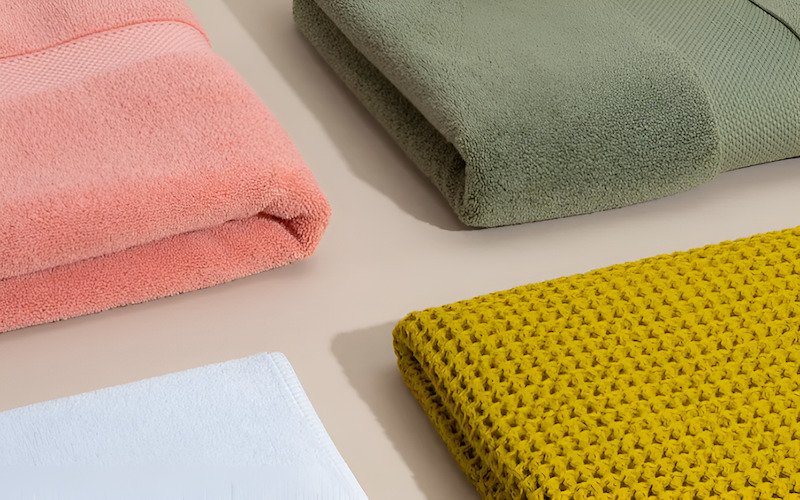
4.2 Baby items
Terry cloth is also very popular for baby items.
- Baby bibs (to catch drool and food spills).
- Burp cloths (for cleaning up messes).
- Hooded baby towels (to keep baby warm and dry after a bath).
- Soft washcloths for gentle cleaning.
4.3 Clothes and beachwear
Terry cloth shows up in our wardrobes too, especially for comfort and absorbency.
- Beach Items: Large terry cloth beach towels are a must for a day at the beach or pool. Terry cloth is also used for beach cover-ups or ponchos.
- French Terry Clothes: Remember French terry? It’s used for many comfortable clothes like hoodies, sweatshirts, sweatpants or joggers, and casual shorts.
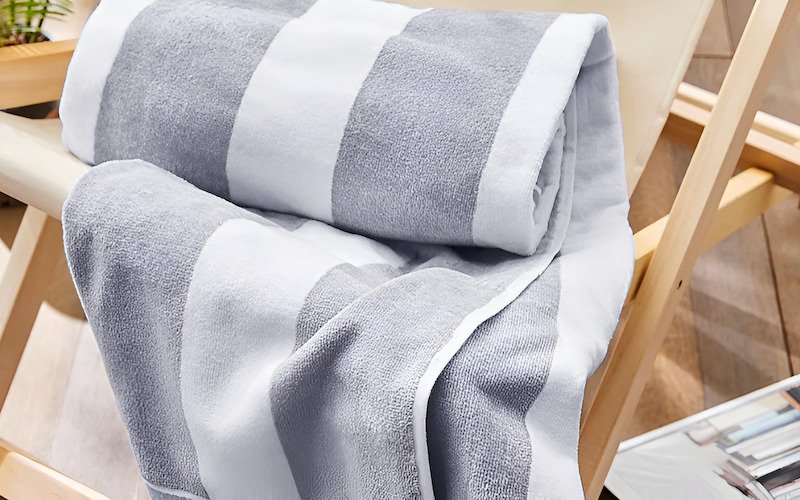
4.4 Cleaning
Terry cloth is also great for making cleaning cloths or rags. It’s absorbent, so it can soak up spills. The looped texture can help to scrub away dirt gently. Plus, it’s durable, so these cloths can be washed and reused many times, which is good for the environment and saves money.
5. How to take care of your terry cloth items
Taking good care of your terry cloth items helps them stay soft, absorbent, and last longer.
5.1 Washing tips
- Wash Before First Use: It’s a good idea to wash new terry cloth items like towels before you use them for the first time. This helps remove any dust and can make them more absorbent.
- Separate Colors: Wash white and light-colored terry items by themselves. Wash dark colors separately to prevent colors from bleeding.
- Avoid Fabric Softeners (Important!): Try not to use liquid fabric softener too often on terry cloth, especially towels. Fabric softener can leave a coating on the loops that makes them less absorbent over time.
- Don’t Overload the Machine: Don’t put too many items in your washing machine at once. Terry cloth items need space to move around to get really clean.
- Use Mild Detergent: A gentle laundry detergent is usually best.
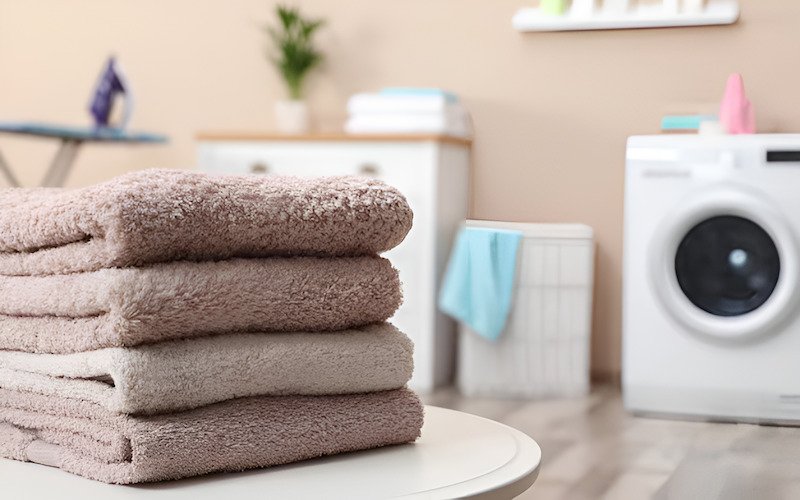
5.2 Drying tips
- Tumble Dry (if appropriate): Most terry cloth can be put in a clothes dryer. Use a medium or low heat setting. Very high heat can damage cotton fibers over time.
- Avoid Over-Drying: Try not to dry your terry items until they are completely crispy. Taking them out when they are just dry helps keep them softer.
- Shake Them Out: Before you put terry items in the dryer, give them a good shake. Shake them again when you take them out. This helps to fluff up the loops.
5.3 Keeping it soft and absorbent
Sometimes, towels can feel a bit stiff or not soak up water well. This can be from a build-up of detergent or minerals. Here’s a tip: About once a month, try adding about half a cup of plain white vinegar to the rinse cycle when you wash your towels.
Don’t use detergent in this special wash, just the vinegar. The vinegar helps remove build-up and can make towels softer and more absorbent again. Don’t worry, your towels won’t smell like vinegar after they are dry!
6. Thinking about brands: Labels on terry cloth products
If you make or sell terry cloth items, labels are important.
6.1 Why labels matter on terry items
- Brand Name: For businesses, labels show the brand name and logo, helping people remember the brand.
- How to Care: Labels are very important for telling people how to wash and dry their terry cloth things correctly.
- What It’s Made Of: Labels can also say what the terry cloth is made from (for example, ‘100% Cotton’).
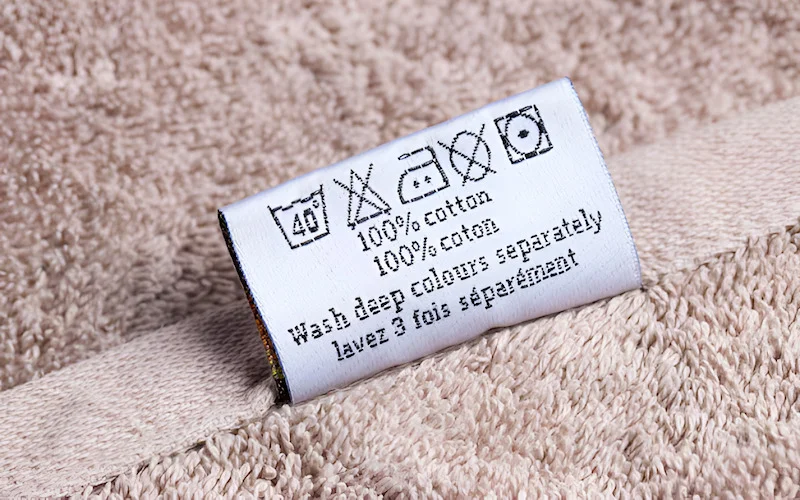
6.2 What kind of labels work well?
Choosing the right label is important for terry cloth items. Here are some good label types that Packlove can help you with:
Woven Labels (a label made by weaving threads together, like on clothing necklines):
- These are made by weaving threads together. They look very professional.
- Benefits for Terry: They are very strong and last through many washes, great for towels and bathrobes. They can also be made soft.
Many brands choose these for a high-quality look.
Heat Transfer Labels (a label applied to fabric using heat and pressure, often tagless):
- These are printed onto special paper and then transferred to fabric using heat. There’s no separate tag.
- Benefits for Terry: They are super smooth, excellent for French terry clothing, baby items, or anything where you want a ‘no-tag’ feel.
Care Labels (Printed Satin/Nylon):
- These labels give washing instructions and material content. They are usually printed on soft satin or nylon.
- Benefits for Terry: These are essential! They help customers care for their terry items, making them last longer.
6.3 Choosing the right label
The best label for your terry product depends on what the item is and how it will be used. Think about:
- Is it a thick, luxurious bath towel needing a durable woven label?
- Is it a soft baby bib where a smooth heat transfer label is best?
- Will it be washed very often at high temperatures?
7. Your terry cloth FAQs
7.1 Is terry cloth good for sensitive skin?
Usually, yes. Terry cloth made from 100% cotton is often good for sensitive skin because cotton is natural and soft. If skin is very sensitive, look for high-quality cotton or organic cotton terry cloth.
7.2 Can terry cloth be made waterproof?
By itself, terry cloth absorbs water. But sometimes, a waterproof layer is added to the back of terry cloth for items like baby bibs or mattress protectors. So, the terry top layer absorbs, and the bottom layer stops leaks.
7.3 How is French terry different from regular terry cloth again?
Quick reminder: Regular terry cloth has loops on both sides. French terry has loops on only one side and is smooth on the other. French terry is also usually lighter.
7.4 Why do my towels sometimes feel stiff?
Towels can feel stiff from detergent build-up, fabric softeners, over-drying, or hard water. Try the vinegar rinse tip we mentioned earlier!
Explore more:
So now you know! Terry cloth is a special fabric with tiny loops that make it very absorbent and soft. It’s used for so many things, from your fluffy bath towels and cozy bathrobes to comfortable clothes and even cleaning cloths. Terry cloth is a simple but very clever and useful fabric we use almost every day!
Have more questions about fabrics or need help with custom packaging and labels for your brand? The team at Packlove is here to help! Visit us at Packlove.






















